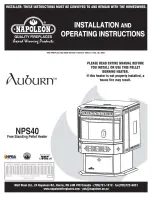
Subject to change because of technical improvements
17
Extinguishing the fire
Do not add fuel and just let the fire go out. If a fire is
damped down by reducing the air supply, harmful sub-
stances will be released. For this reason, the fire
should be allowed to go out naturally. Keep an eye on
the fire until it has gone out. All air inlets can be closed
once the fire has died completely.
Removing ash
After wood has been burnt, a relatively small amount
of ash remains. This ash bed is a good insulating layer
for the stove base plate and improves combustion. It
is a good idea to leave a thin layer of ash on the stove
base plate.
The flow of air through the fire plate must not be
obstructed, however, and no ash may be allowed to
accumulate behind a cast-iron inner plate. Remove
the excess ash regularly.
2
1
3
09-20021-159
1. Open the door of the appliance.
2. Use the scraper to open the ash opening (1).
3. Use the scraper supplied to sweep the excess ash
into the ash pan.
4. Using the glove supplied, remove the ash pan (3)
and empty it.
5. Replace the ash pan and close the door of the
appliance.
Fog and mist
Fog and mist hinder the flow of flue gases through the
flue. Smoke can blow back and cause a stench. If it is
not strictly necessary, it is better not to use the stove
in foggy and misty weather.
Resolving problems
Refer to the appendix "Diagnostic diagram" to resolve
any problems in using the appliance.
Maintenance
Follow the maintenance instructions in this chapter to
keep the appliance in good condition.
Flue
In many countries, you are required by law to have
your chimney checked and maintained.
At the start of the heating season: have the
chimney swept by a recognised chimney sweep.
During the heating season and after the chimney
has not been used for a long time: have the
chimney checked for soot.
At the end of the heating season: close off the
chimney and plug with newspaper.
Cleaning and other regularly
maintenance
Do not clean the appliance when it is still
warm.
Clean the exterior of the appliance with a dry lint-
free cloth.
You can clean the appliance interior thoroughly at the
end of the heating season:
If necessary, first remove the fire-resistant inner
plates. See the chapter "Installation" for
instructions on removing and installing the inner
plates.
If necessary, clean the air supply ducts.
Remove the baffle plate at the top of the appliance
and clean it.
Checking fire-resistant inner plates
The fire-resistant inner plates are consumables that
are subject to wear and tear. Vermiculite inner plates
are fragile. Do not knock the inner plates with logs.
Summary of Contents for ROCK 350
Page 59: ...Subject to change because of technical improvements 25 ROCK 500 100 150 ø150 09 20021 171 ...
Page 61: ...Subject to change because of technical improvements 27 ROCK 500 TB 100 150 ø150 09 20021 169 ...
Page 62: ...ROCK 500 WB 100 150 ø150 09 20021 170 28 Subject to change because of technical improvements ...
Page 105: ......
















































